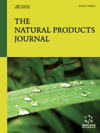- Home
- A-Z Publications
- Natural Products Journal, The
- Previous Issues
- Volume 11, Issue 1, 2021
Natural Products Journal, The - Volume 11, Issue 1, 2021
Volume 11, Issue 1, 2021
-
-
Health Beneficial Potential of Pectolinarigenin on Human Diseases: An Updated Review of Medicinal Importance and Pharmacological Activity
More LessAuthors: Kanika Patel and Dinesh K. PatelMedicinal Plants are valuable source of phytochemicals which have been used in the medicine as source of raw material since very ancient time in the world. Flavonoids are one of the important classes of phytochemical basically present in the fruits, vegetables, grains, wine, tea etc. Flavonoids also play an important role in the defense mechanism of plants and produce different colours in the plants. Pectolinarigenin is a natural f Read More
-
-
-
Aloe Vera (Aloe barbadensis) Gel for the Management of Gastroesophageal Reflux Disease (GERD)
More LessBackground: Gastroesophageal Reflux Disease (GERD) is introduced as a result of lower esophageal sphincter weakness, which returns contents of the stomach to the esophagus. Aloe vera (Aloe barbadensis) gel is known as a healing agent for the treatment of internal and external ailments. Modern researches have confirmed potential therapeutic effects of A. vera gel for GERD, but there is no review study to evaluate the eff Read More
-
-
-
Phytochemistry and Pharmacology of the Genus Zanthoxylum (Rutaceae): A Review
More LessBackground: The genus Zanthoxylum (Rutaceae) represents an interesting source of bioactive compounds, and more than 220 accepted species of this genus are distributed in the warm temperate and subtropical regions of the world. Different plant parts of Zanthoxylum species have been used traditionally as medicines for various diseases affecting both humans and animals. Based on traditional knowledge, several phytoc Read More
-
-
-
Antioxidative and Hepatoprotective Effects of Rubus canescens DC. Growing Wild in Lebanon
More LessBackground: Plants of the genus Rubus (family Rosaceae) have been used for diverse medicinal purposes for centuries. We hypothesized that the scarcely investigated R. canescens DC., like other species of the genus Rubus, exhibit prominent antioxidant activity. Objective: The present study investigates the in vitro and in vivo antioxidant activity of fruit juice as well as aqueous and methanolic extracts of the areal parts of Rub Read More
-
-
-
Antibacterial Activity of Steroids Isolated from the Madagascar Marine Sponge Biemna laboutei: Δ7 Steroids as New Potential Agents Against Pathogenic Bacteria
More LessBackground: Nowadays, the efficiency of antibiotics is endangered by the development of resistant bacterial strains. Consequently, novel bioactive agents are intensively searched. Marine sponges are well-known for being major sources of bioactive compounds, including unusual sterols. Until now, among sterols, noteworthy antibacterial activity has been reported exclusively for Δ5 sterols. Objectives: This study aims to describ Read More
-
-
-
LC-MS/MS Profiling of 37 Fingerprint Phytochemicals in Oenanthe fistulosa L. and its Biological Activities
More LessBackground: Oenanthe fistulosa L. (Apiaceae) is often associated with damp soils. Its underground parts and the young leaves are mainly cooked with other vegetables. Objective: The aim of the current work was to investigate the chemical profile of dichloromethane (DCM), Ethyl Acetate (EA) and n-butanol (BuOH) fractions of O. fistulosa through analysis of 37 phytochemicals by LC-MS/MS and to evaluate their biological activiti Read More
-
-
-
A Comparative Analysis of Bark and Leaf Essential Oil and their Chemical Composition, Antioxidant, Anti-inflammatory, Antimicrobial Activities and Genotoxicity of North East Indian Cinnamomum zeylanicum Blume
More LessAuthors: Roktim Gogoi, Neelav Sarma, Rikraj Loying, Sudin K. Pandey, Twahira Begum and Mohan LalBackground: Cinnamomum zeylanicum Blume ( Lauraceae) bark and leaf essential oil possesses eugenol as the major component. Both the essential oils have the potential antioxidant, anti- inflammatory, antimicrobial and negligible genotoxicity. Objective: A comparative chemical composition and biological evaluation of Cinnamomum zeylanicum Blume, bark and leaf essential oils, originated from North-East India Read More
-
-
-
Anticancer Potential of Michelia champaca Linn. Bark Against Ehrlich Ascites Carcinoma (EAC) Cells in Swiss Albino Mice
More LessBackground: Adverse side effects of currently available therapies against cancer, leads scientists to find effective compounds from natural sources. Objective: In the present study, stem-bark of Mycelia champaca is subjected to evaluate its antiproliferative effect against Ehrlich Ascites Carcinoma (EAC) cells. To date, the anti-proliferative effects of M. champaca bark extract against EAC cell line has not been reported els Read More
-
-
-
Response Surface Methodology Towards Optimization of Calotropis Procera Essential Oil Extraction by Using Supercritical CO2
More LessAuthors: Hossein Zaeri, Bahareh K. Moghadas, Bijan Honarvar and Ali Shokuhi RadAim: In this research, we aim to investigation on the extraction of essential oil from Calotropis Procera with the family name of Asclepiadaceae, by supercritical carbon dioxide (CO2) solvent. Objective: The comparison of the yield and chemical profile of the extracts achieved by this method with those resulted by the conventional Hydro distillation method. Methods: The extraction experiments were carried out in a bench-scale SC Read More
-
-
-
Lipid Profile of Pig Tissues Contrasting in Meat Production
More LessBackground: Studies were carried out on two breeds of pigs - Pietrain (P), and Kemerovo (K), contrasting in composition of carcasses, and their hybrids. Objective: The purpose of this work was to establish the characteristics of the composition of lipids of intramuscular fat (IMF), back fat and serum, organoleptic qualities in animals of these breeds. Methods: Animals of 10 individuals in each group were fed on a standard feed Read More
-
Most Read This Month
Article
content/journals/npj
Journal
10
5
false
en


